While walking the yard to draw the boundaries and landscaping, make note of which areas are wettest and which are driest. To help with dividing the sprinklers into stations later on, also mark sunny and shady areas so they can be separated for individual watering.
Decide which edges to start placing sprinklers...
Decide which sides of the yard should have sprinklers along the edge. For example, hard edges such as curbs, driveways and foundations usually have sprinklers adjacent to the edge. It is more efficient to place sprinklers along every edge to avoid watering over the property line, and to provide optimum overlap at all points along the edge, but this also increases the installation cost slightly. It is less important to have sprinklers right on property boundaries where there is no sharply defined edge since a slight variation in watering uniformity along that edge will be less obvious. Placing a row of full circle sprinklers about one quarter to one sixth of the diameter from an edge will not water quite as evenly along the edge and will throw water over the property line or onto a fence, but it reduces the installation cost slightly. (Less money now for hardware, more money later for water.) If you have shrubs along the fence and wish to water them at the same time as the lawn, then the sprinklers should be placed several feet in front of the shrubs rather than behind them. If the sprinklers are placed behind the shrubs and must throw water over them, then the spray will be blocked when the shrubs grow larger, resulting in terrible watering uniformity. If the street does not have a curb and driving off the pavement is likely, consider setting the sprinklers back from the edge and spray back to the street.
Determine whether square spacing or triangular spacing works best...
Measure the width and length of the largest open areas (from the sprinkler locations you chose near the edges above) to see how many rows of sprinklers are required. Look at the shape of the open area to see if there is an obvious choice between square or triangular spacing. See the figure below to see how to space rows for either square and triangular spacing. Use square spacing unless there is a reason (like those listed below) to use triangular spacing. If your corners are near 60° or 120° you may find triangular spacing fits better. Another reason to use triangular spacing might be if an extreme amount of row compression is required to make square spacing fit. For example, if the rows must be compressed more than 0.86 times the head spacing, you should consider triangular spacing, since this automatically favors spacing rows closer than heads within a row.
| Drawings of spacing measurement |
Measurements for triangular spacing
ideal row spacing = 0.86 times head spacing |
Measurements for square spacing
ideal row spacing = head spacing |
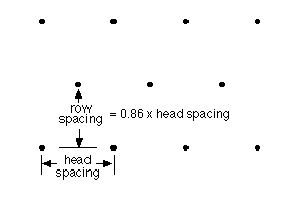 |
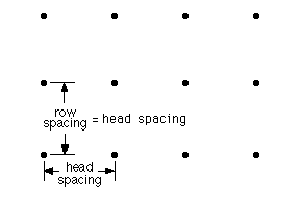 |
Determine how many rows of sprinklers you'll need...
Divide the distance between the first and last sprinkler along opposite edges to determine how many rows and head spacing intervals you'll need. You can compress the row spacing or head spacing or both. Don't stretch spacing beyond recommended distances at all. If possible, pull everything in to 90% of recommended spacing, more in windy areas. This is especially important to do for windy areas to improve watering uniformity. For 15 ft spray sprinklers, the head spacing is 15 ft maximum, not 30 ft! It is good design practice to space 15 ft. sprinklers at 14 ft. intervals. The spacing for rotors is determined using the nozzle charts for PGJ, PGP/PGS/PGH, I20, or I40 rotors depending on which products you choose. If the nozzle you select has a 30 foot radius, do not space the sprinklers further than 30 feet apart, preferrably 25 to 27 feet apart. You may need to play with several patterns to see what seems to work best. Count how many sprinklers each option uses, and what tradeoffs each approach requires. Pick whatever layout seems to work best with the fewest sprinklers.
| Drawings of ideal square spacing |
| Sprinklers placed along right property line |
Placed several feet from property line |
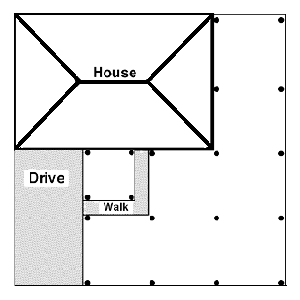 |
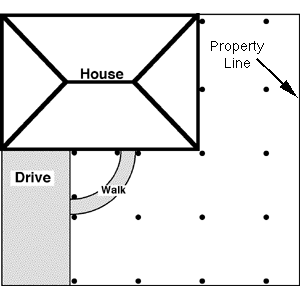 |
Square or triangular spacing?
The figure below shows the use of 15 foot radius spray sprinklers in an area that measures 26 feet from top to bottom. This requires three rows of sprinklers to avoid spraying over the top and bottom edges, but a row spacing of 13 feet results, and sprinkler "A" sprays water on the patio.
| Square spacing example |
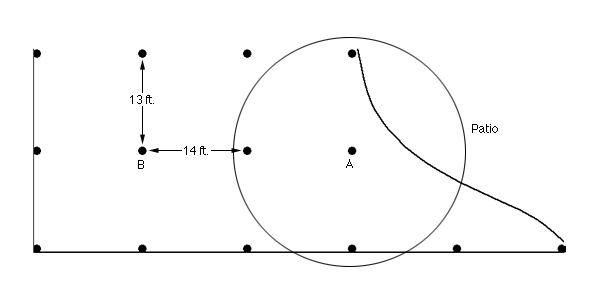 |
Another possiblity would be to use triangular spacing, which normally results in a 13 foot row spacing for 15 foot sprinklers(15 feet times 0.86). If sprinkler "A" is placed against the patio edge and the full nozzle replaced with a 240 deg nozzle, there will be very little water sprayed on the patio. Sprinkler sprinkler "B" is moved to the right several feet. You could use a full circle nozzle for sprinkler "B", but a three quarter nozzle (270 deg) can be used if a back-up sprinkler with a smaller radius (sprinkler "C") is added. The final triangular layout shown below with the back-up sprinkler will water the area more efficiently than the square layout shown above.
| Triangular spacing example |
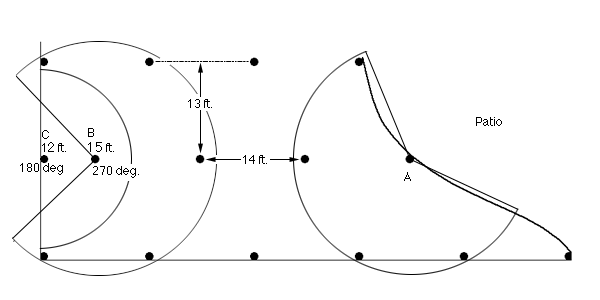 |
Determining rotor nozzle sizes...
Since some rotors may be watering a full circle, while others will be watering a part of a circle, you need to factor this into the flow rate for the nozzle chosen for each sprinkler. To a large degree, the radius (throw distance) for a nozzle is relatively independent of the nozzle flow rate. A sprinkler watering a full circle should put out four times as much water as a sprinkler in the corner of the yard watering only a quarter circle. Likewise, a sprinkler in the middle of a long straight edge should put out half as much water as the ful circle sprinkler. If you don't factor this into your nozzle selection, you won't have uniform watering, and you will spend a lot of unnecessary money on water that is wasted! Most consumer grade rotors have a very poor selection of nozzles. If you need several different arcs for your job, you will definitely need a commercial grade sprinkler with a large selection of nozzles.
Sizing rotor nozzles...
If you're using rotor sprinklers in your design, look at our page on sizing rotor nozzles, otherwise, click on the "next" button below.
Links to continue to the next page are found at the bottom of this page.
| If you've benefited from the help we've provided on our site but you choose not to purchase your parts from us, we hope you will consider making a small donation to help offset the cost of maintaining this site. To make a donation, you can click on a button below and follow the on-screen instructions. |
|
|
|
|
Thanks!
The staff at WaterTips.com |
|








